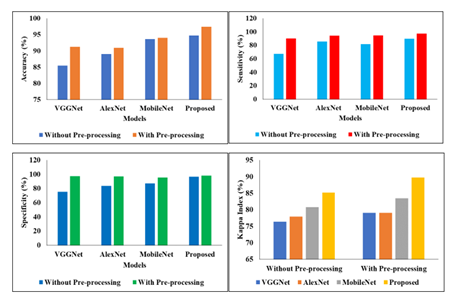Prediction of Alzheimer Disease using LeNet-CNN model with Optimal Adaptive Bilateral Filtering
DOI:
https://doi.org/10.17762/ijcnis.v15i1.5706Keywords:
Alzheimer's disease, Adaptive Bilateral Filter, Adaptive equilibrium optimiser, LeNet, Convolutional Neural Network.Abstract
Alzheimer's disease is a kind of degenerative dementia that causes progressively worsening memory loss and other cognitive and physical impairments over time. Mini-Mental State Examinations and other screening tools are helpful for early detection, but diagnostic MRI brain analysis is required. When Alzheimer's disease (AD) is detected in its earliest stages, patients may begin protective treatments before permanent brain damage has occurred. The characteristics of the lesion sites in AD affected role, as identified by MRI, exhibit great variety and are dispersed across the image space, as demonstrated in cross-sectional imaging investigations of the disease. Optimized Adaptive Bilateral filtering using a deep learning model was suggested as part of this study's approach toward this end. Denoising the pictures with the help of the suggested adaptive bilateral filter is the first stage (ABF). The ABF improves denoising in edge, detail, and homogenous areas separately. After then, the ABF is given a weight, and the Adaptive Equilibrium Optimizer is used to determine the best possible value for that weight (AEO). LeNet, a CNN model, is then used to complete the AD organization. The first step in using the LeNet-5 network model to identify AD is to study the model's structure and parameters. The ADNI experimental dataset was used to verify the suggested technique and compare it to other models. The experimental findings prove that the suggested method can achieve a classification accuracy of 97.43%, 98.09% specificity, 97.12% sensitivity, and 89.67% Kappa index. When compared against competing algorithms, the suggested model emerges victorious.
Downloads
Published
How to Cite
Issue
Section
License
Copyright (c) 2023 International Journal of Communication Networks and Information Security (IJCNIS)

This work is licensed under a Creative Commons Attribution-NonCommercial-ShareAlike 4.0 International License.




